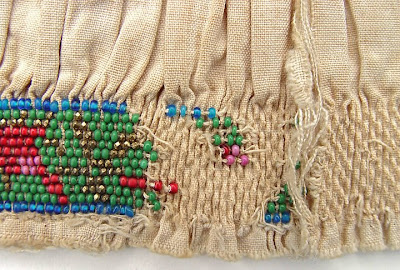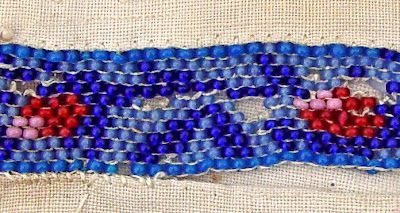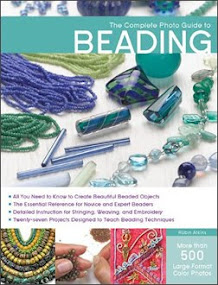
This post is about a mystery... one I've pondered for a long time. Below you will see some precious fragments from beaded clothing. Some of it may be more than 100 years old! The mystery concerns the origins. Maybe one of you knows the answer.... And if you don't, just enjoy seeing it!
I bought this collection at a flea market in Seattle in 1992 or so. The seller told me he had bought it from a sidewalk peddler in Mexico City. The peddler and he did not have a language in common, so he learned nothing about them.
In each set, the first picture, the one with the rule, will be approximately the actual size when you click to enlarge it. The other, detail pictures will be larger than actual size so that you can see exactly how this beautiful work is done. When you click to enlarge you can just about see every thread! I'll show them in sets and make a few comments about the techniques and materials for each set.


I believe these little rabbits may have been part of a sampler, or possibly a practice piece. The fabric is a fine, even-weave cotton or linen and appears to be homespun. The technique seems to be like counted-thread, slanted Gobelin needlepoint embroidery, worked on the diagonal across three threads of the fabric. There are 21 beads in a one-inch line or 441 beads per square inch. I think the beads are size 20 or 22. The size and colors of the beads suggest that this piece may be from the late 1800s or early 1900s.



This piece may be the oldest of the lot. The fabric is dark from age and there is much damage to the threads and fabric, which appear to be cotton or linen. Here the technique is bead-embellished lines of running stitches which tightly pleat the fabric. There are about 40 pleats per linear inch. Up to 20 beads per inch are added every other pleat according to the pattern. The same thread gathers and adds beads. There are 15 rows (top to bottom) of gathering stitches per inch.
The beads used on this piece are slightly larger than the ones used on the rabbit piece. I'd say they are a mixture of 20s and 18s. It looks as though the stitches are counted with two threads per stitch. And the rows alternate whether the stitch is on front or the back. I think the technique may be some type of smocking, although I can't find it in the on-line guides to smocking stitches. The band at the top is back-stitched with thread, making a pattern visible on both sides of the piece.
The design seems European, perhaps Transylvanian in origin. There is a suggestion of folk art to the design.




This piece amazes me. Like the one above, the fabric is smocked with rows of horizontal running stitches. One bead is added per stitch. There are 34 pleats per inch, 17 beads per linear inch, 18 rows per vertical inch or 306 beads per square inch. The design again seems European, typical of the late Victorian Era.


This piece is the same smocking technique, with even smaller beads. Here there are 50 pleats and 25 beads per linear inch. The beads are so small they look like little grains of finely ground pepper. I think they're about size 22 or 24. There are 22 rows per inch, which makes 550 beads per square inch! The bottom is hand-hemmed. Might this have been the cuff on the sleeve of a blouse?


This piece of beaded smocking has 16 beads per linear inch. The bird and berry design may be a bit more recent than the previous examples, but could still be European.


This deer and flower design has the look of Latin America to me. The beads are a little larger than in the above example, with 15 per inch.


This piece seems much more recent to me. The fabric may be homespun cotton or possibly machine made. The hem is machine stitched, unlike all the other pieces which are totally hand stitched. The beads are probably size 13. There are 13 beads per linear inch. This llama (or alpaca design) seems to be Latin American.





This piece is a real mystery. What part of the garmet was it from? The technique, like the rabbit piece, seems to be counted-thread stitching. The beads are quite small, mostly size 18. I have no sense of the design origin, especially the coloring of the dog. The thread, like the home-spun fabric, is either cotton or linen. I love this design, so I've shown some of the details. Isn't the leaf great?!


This is one of two pieces in the collection that use a different technique. The strips of beadwork are done with an off-loom weaving technique. I'm not sure what the weaving method is... perhaps a type of brick stitch. The woven strip is used as a seam embellishment, with a piece of fabric whip-stitched to each edge of the strip. The beads are quite tiny... size 18 or 20.

This last piece in the collection is so tattered... It's done the same way as the one above with size 20 or 22 beads woven into strips and sewn along the edges to home-spun fabric. I'm intrigued by the design because each strip is a different pattern. What part of a garmet could this be from? It seems to have been sewn to an adjoining pleated or smocked piece.
That's it. Aren't these amazing? My theory is that they are all from some village in Mexico or South America (maybe Guatemala) where a group of Eastern (?) Europeans settled at the turn of the century. The women in this group embellished clothing with these three techniques using tiny glass seed beads they brought with them. They taught their children and the tradition was passed down for several generations. Initially the designs were familiar, floral designs of Europe. But over time, they began to use local motifs. What do you think about my theory? Or do you, perhaps, have more concrete knowlege about this work? If you know someone in the know, please call their attention to this post... This mystery needs to get solved!
Thanks for looking!
* * * * * * * * * *
Feb. 24, 2009
I've just learned what is probably the correct name for this type of smocking from Barbara Meger, who does a lot of smocking and is a member of EGA. She thinks this is a type of pleatwork called Italian shirring, which unlike other forms of smocking is not intended to stretch. Here's something I found on this website that may interest you.
"Shirred fabric is a form of fabric manipulation. Modernly it is a form of smocking called Italian smocking or Italian shirring. Shirring runs the gathering threads in a way that creates designs in the pleats as they are gathered. An alb, credited to be that of St. Bernulf, dating from the 11th century is possibly the earliest form of this technique. A second alb that of Thomas Beckett’s from the 12th century also has this form of shirring in the pleated gores. It does not seem to be a common technique during the next 400 years. It is not noticeably seen in portraiture, nor does it show up in the few extant garments until the end of the 16th century/ early 17th century . One example dating 1600-1650 is on a men’s Italian shirt, currently in the collection of the Los Angeles County Museum of Art."
* * * * * * * * * *
Feb. 24, 2009
The Lone Beader wrote a comment to this post suggesting that I donate this historical beadwork (I love that term for it!) to a deserving museum. That's exactly what I intend to do! I'm considering the The Textile Museum in Washington DC.
* * * * * * * * * *
April 2, 2009
From a couple of books and this site, I have learned that these fragments very likely originated in the Cholula-Atlixco-Puebla Valley region of Mexico and were constructed by Nahua natives. Check this picture...

Notice the side panel and it's similarity to the panel pictured above with the pink dog? The mystery seems to be solved at last!
















I have no solution to your wonderful mystery but I am amazed at the wonderful bits of history that are in your possession.
ReplyDeletePerhaps Valerie Hector could solve some of this mystery for you. I have one of her books that shows quite a lot of Latin American beadwork.
Kathy V in NM
I can't be any help but I can say you have an amazing collection of bead work. I'll be curious to see if you solve the mystery. It must be wonderful to actually hold these pieces in your hands. If only they could talk!
ReplyDeleteGreat post! I love historical beadwork! I agree, it does look like to be South American, but I'm not sure. Maybe Diana Friedberg or someone at the British Museum would know... Great photos, though! I hope you will dontate these to a museum at some point! That is where they belong. :D
ReplyDeleteWow, they truely are amazing. The beaded smocking is astonishing. Can you still get beads that tiny? Can you see the hole?!!
ReplyDeleteYou are lucky to have them and they are lucky to be in the care of someone who values and appreciates them so greatly.
Your theory sounds good, but I have no expert opinion to add. Hope you (and we) will discover more.
Thanks so much for showing them to us.
CA
What treasures, what prettiness, and even two rabbits who found their way to you!
ReplyDeleteI know nothing whatsoever about smocking, nor have I ever tried it. BUT - I know someone who might be able to help you, namely Natacha Wolters, the French bead and textile artist living in Berlin. If she herself cannot bring light into the matter, she is bound to know other people she could refer you to. Her e-mail address is:
nat.wolters@t-online.de.
If the contact should fail for some reason, let me know.
Another idea: Do you know of any textile museums or museums with a respective department? That might be helpful, too.
Best wishes,
Sabine
I am in awe of this beadwork! I can't stop thinking about what kind of needles they used and where they got them or how they MADE them???? And especially...How On Earth Did They Thread Them!!!!
ReplyDeleteI am so glad that you will be donating these pieces to a museum...Thank you for sharing the fascinating details!
Thank you, also, for your comments on my Rage Doll...They were quite observant and interesting. I actually felt that the leather wrapping was anchoring me to the earth rather than confining me...We'll see what the next doll in the process has to say!
Take care, Robin! I am so looking forward to meeting you in person when you come to Colorado!
Much love,
Camilla
Robin,
ReplyDeleteThese are really beautiful! I absolutely LOVE the bunnies at the top. The scale is surprising. I'd like to find beads that are teeny tiny - smaller than mill hill petites, which is the smallest I can find around here. It would be fascinating to recreate something like that - and what a darling Easter dress it would make for a child!
But, oh. The fingers. Ouch.
Thanks for al these photos - they're really beautiful!
What treasures. You can just see the women working on them and keeping part of their heritage alive.
ReplyDeleteRobin, I LOVE the Lone Beader's suggestion of donating the beadwork! Speaking personally, I work for the small Historical Museum here on our little island and I know that so many of these kinds of non-profit organizations are dependent on donations of this kind. We have only a tiny amount of beadwork in our collection (Native American) and it's not my area of expertise, so I am unable to suggest who you might approach. But I think your idea of approaching The Textile Museum in D.C. is a good one -- if anything, they might be able to identify the source locale of the work. Then you could decide whether you wanted to contact an even smaller museum closer to the source (can you tell I have a soft spot for the little guys? :>} Just a thought.
ReplyDeleteThis will be an exciting story to follow, please keep us posted! I hope it will not be too difficult for you to part with them...
Christi C.
WA state
I'm of absolutely no help on this. It is fun to view and I enjoyed the journey in time. Thanks.
ReplyDeleteRobin, This work is absolutely fantastic!!! I think you are on the right track in giving it to a museum. All I can think of is it was made without benefit of a bright, electric light bulb! Just amazing!
ReplyDeleteThanks, Robin, for your comments on my blog and I hope my daughter was of help to you. I'm on the mend, tho not great yet and trying to get "caught up." Hope to hear from you again soon.
I'll be returning to hear your latest on the mystery!
Pat
Oh good, I am so glad that Barbara Meger was able to help. She's our resident "smocking" expert -- and I think the donation to a museum is a wonderful idea. We have a member in our guild who has connections with the Textile Museum if one of my other friends hasn't already volunteered that info ;)...
ReplyDeleteThese are truly inspiring pieces of history and it seems such a shame that so much of textile history is lost. I have bookmarked this post and will forward it to the textile curator at the Baltimore Museum of Art -- she may know something or know someone else who may be knowledgeable. I found it interesting that the gold beads used in a few of the beads are faceted and slightly larger than the seed beads. The use of the same beads leads me to believe that the work may have been done in one family versus one village. I guess when the garment wore out...the beaded pieces were saved. It would be very FUN, I think, to attempt this shirring effect to play with...it would create some absolutely beautiful effects...hmmm. They're definitely going in my inspiration file for sure. Thanks a heaping amount for sharing this with the world. What a gift!
Robin, these are really neat! I can guess where they might be from but they would only be guesses! Scandanavia for one - I think the oldest one, the others almost look Peruvian in feel. My 2 cents worth. What a treasure they are anyway. Anyone would be luck to have these, just to look at.
ReplyDeleteThanks for your lovely comments on my blog - you're so inspiring.
Thank you so much for showing it to us. I wish I could touch it, just to feel it. I think it is God's wish that these pieces reached you, into safe hands.
ReplyDeleteI enjoyed reading this.
regards
anitha
All this beadwork is amaizing! Thanks for sharing.
ReplyDeleteIrina (Moscow, Russia)
Long time no read, but if you want to, have a look into my recent post. There is a thank you waiting for you, if you like.
ReplyDeleteBest wishes
:-Tally-:
What a fascinating post! What took me so long to stop by?
ReplyDeleteOne thing that hit me was your estimated bead sizes vs. the number of beads stitched per inch. It seems that they roughly correlated. Size 18 - 18 beads per inch. Size 22 to 24 - 25 per inch. Do you know if that is a coincicence or if beads are designed by size to equate to a number of beads per inch?
Inquiring minds want to know.
Thank you!
Laura
Tarzana (Los Angeles), CA
Fascinating! I've scheduled a link to this post to go live on my blog later today. I hope it brings you a few new visitors.
ReplyDeleteDenise
http://needlework.craftgossip.com